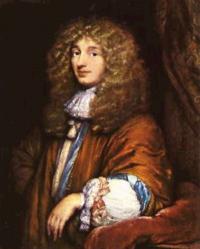Christiaan Huygens (Christian Huyghens)
Mathematician, astronomer and physicist, b. 14 April 1629 (The Hague, Netherlands), d. 8 July 1695 (The Hague).
 Huygens was the son of a Dutch diplomat who, following the intellectual climate of the time, had an interest in Latin, science and poetry and corresponded with many of the leading scholars. The young Christiaan studied mathematics and law at the University of Leyden and the College of Breda.
Huygens was the son of a Dutch diplomat who, following the intellectual climate of the time, had an interest in Latin, science and poetry and corresponded with many of the leading scholars. The young Christiaan studied mathematics and law at the University of Leyden and the College of Breda.
Mathematical publications and the discovery of the true shape of the rings of Saturn made Huygens' name known throughout Europe, and when he visited Paris in 1659 and again in 1660 this and his wealthy family background led to meetings with Pascal.
Huygens was initially mainly interested in astronomy, but the limitations of the available telescopes led him to develop a new method of grinding and polishing lenses and a search for an accurate measurement of time. In his work Horologium he described his discovery of the pendulum as a regulator for clocks and its use.
Huygens' best years were in Paris under king Louis XIV from 1666, when he was one of the founding members of the French Academy of Sciences, to 1681, when the increasingly hostile policy of Louis XIV against protestants caused Huygens to move to Holland again. Although he knew most of the famous scientists of his time personally - he had met Newton while lecturing in London and had a lifelong friendship with Leibnitz - his scientific achievements were always overshadowed by the fame of others, and Huygens spent his last years in ill health and feeling more and more isolated.
His brilliant work Horologium Oscillatorium was published during his time in Paris. Among its many mathematical problems it covered a complete analysis of oscillating and rotating bodies, the centrifugal force and collisions. His insistence on mechanical explanations sometimes lead him astray, and he tried to oppose Newton's theory of gravity as containing too much mathematics and not enough physics.
Another work from his time in Paris, published in 1690, was the Traité de la Lumière ("Treatise on Light"). It gave elegant and insightful explanations for the phenomena of reflection and refraction based on the principle of wave fronts that encounter an obstacle. The work deserved much more attention than it received. Its value was only discovered again in the early 19th century, when Huygens's name emerged out of the shadow of Newton and others of his contemporaries.
home
 Huygens was the son of a Dutch diplomat who, following the intellectual climate of the time, had an interest in Latin, science and poetry and corresponded with many of the leading scholars. The young Christiaan studied mathematics and law at the University of Leyden and the College of Breda.
Huygens was the son of a Dutch diplomat who, following the intellectual climate of the time, had an interest in Latin, science and poetry and corresponded with many of the leading scholars. The young Christiaan studied mathematics and law at the University of Leyden and the College of Breda.